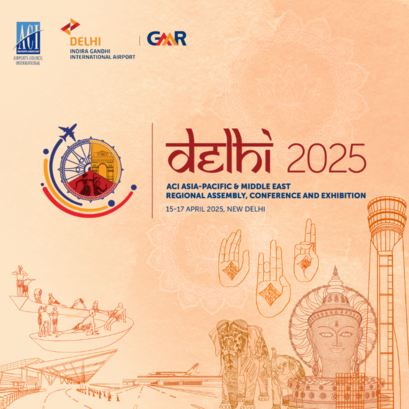Airport Groups: Engines of Recovery
- 2022-10-19
Airports Council International has published a comprehensive study on the business model of Airport Groups, also known as multi-airport operators. The study examined the value created by Airport Groups and how the business model benefits the aviation ecosystem.
The study was done in collaboration with ACI World and other ACI Regional Offices, with the support of established consultants-- ICF and Oxford Economics. The study was made possible with the financial support from Capital Airport Holdings Company, People’s Republic of China.
As we turn the page on COVID-19
There is no doubt that the aviation industry has endured very difficult times over the last two years, grappling with the rapidly evolving pandemic environment. It was no surprise that many of the airport operators were staring at losses, and even predicted to remain in the red as we are still some distance away from full recovery.
During the pandemic, passenger traffic was down over 90% in many markets. A decline in revenue of this scale would not be surprising since airport operators' revenues depend heavily on passenger traffic.
On the other hand, the airport cost structure is characterised by predominantly high fixed costs, particularly in the regular operations and maintenance of major infrastructure components, such as runways and terminal buildings. With supply side constraints on travel and the collapse in demand for air travel, airport operators did not have sufficient traffic to drive down operational costs and achieve economies of scale. As a result, many operators were burning cash every passing day.

Airports Operations and maintenance are cost-intensive
Though some governments provided relief measures and financial support to help airport operators to stay marginally afloat, the support was nowhere near the losses that airport operators were suffering. As such, this phenomenon raises questions about how best airports can be managed and operated effectively and efficiently.
This is where the Airport Groups have distinguished themselves, demonstrating their resilience while managing the crisis so efficiently. The key advantage for the smaller airports within an Airport Group is that they have access to resources that they would not have otherwise if they operated and managed separately as individual entities. While it is common for larger airports to enjoy a broad range of resources and expertise, it would be more efficient and sustainable for smaller airports to tap into the support of a large network.

Emergence of Airport Groups?
Over the last three decades, the airport industry landscape has witnessed the rise of specialized airport operators. Fundamentally, Airport Groups are multi-airport operators, leveraging their expertise and experience to expand their operations both internationally and domestically, many of which, are private companies.
Before the pandemic, these Airport Groups accounted for almost one-third of global airport passenger traffic and about a quarter of global air cargo volumes. Their significant support to global economy included USD74 billion Gross Value-Added (GVA) contribution to global GDP, 2.7 million jobs, and USD12.8 billion in payments to governments.
Airport Groups generated tangible value for a wide array of stakeholders, measured by conventional financial and economic indicators, sector-specific dimensions and the broader socio-economic impacts.
What’s so good about Airport Groups?
Being part of an Airport Group facilitates knowledge exchange with other airports within the Group, including the sharing of best practices, application of new technologies and developments of innovative concepts. It also enables the operators to diversify risks, enhance resilience against shocks and achieve economies of scale and scope.
Size Matters
Just like any other multinational companies, economies of scale and scope is one major benefit. Airport Groups benefit from the efficiency of centralised processes and functions, as well as the ability to buy materials in bulk to reduce costs.
Having a more centralised management function would enable less competitive airports within the group portfolio to reap the benefits of strategic planning, business development, service sourcing, and capital investments that are otherwise difficult to achieve individually.
Airport Groups often operate and manage airports of different sizes globally. As such, it generates resilience against geographic or market-specific shocks. In addition, some Airport Groups belong to wider commercial conglomerates, where business interests may spread to multiple sectors and industries. The diversity of a group creates an additional safety net against negative sector specific exogenous factors and events.
Similarly, operating as part of a group enables airports to benchmark themselves against other airports within the group. Policies, procedures, and standards at group level allow airports to share practices and measures for achieving those common goals. Operation and management standardisations are often achieved by knowledge exchange through different channels, such as meetings of leaders and experts of different airports, or the rotation of staff across airports.
Gearing Up For the Future
As we come out of the pandemic, the term “normal” may carry a total different meaning. The expedited implementation and use of innovative technologies perhaps is one positivity and silver lining over the past two years. The process of digitalisation and technological advancement have certainly enhanced the operational efficiency and improved passengers’ experience at airports, while ensuring hygiene, health and safety.
Airport Groups enjoy the privilege in utilising group resources for research and development. With multiple airports in their portfolios, Airport Groups can deploy their technologies in a diverse range of airports to ensure their latest services and products remain human centric in different operating environments.
The Upshot
ACI predicts global passenger traffic would recover in 2024, with some markets to be recovered slightly later in 2025. The above-mentioned benefits have the common attribute of sharing and leveraging the knowledge, expertise, and experiences of a resource pool far larger and more diverse than any individual airport would possess. The benefits of the Airport Group business model are considered critical and would certainly facilitate the pace of recovery, and growth, going forward.
To learn more about the study, please visit - Value creation by Airport Groups: A study on the airport group operating model and its benefits to the aviation ecosystem - ACI World Store
Philip Kwok is a Economic Research Analyst at ACI Asia-Pacific.
- CATEGORY
- COUNTRY / AREA
- Hong Kong SAR
- AUTHOR
- Mr. Philip Kwok, Economic Research AnalystACI Asia-Pacific










